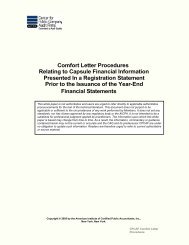May 26, 1999 - Center for Audit Quality
May 26, 1999 - Center for Audit Quality
May 26, 1999 - Center for Audit Quality
Create successful ePaper yourself
Turn your PDF publications into a flip-book with our unique Google optimized e-Paper software.
• Revenue Recognition — Among other things, the SAB will describe the<br />
staff's views about accounting <strong>for</strong> "bill and hold" transactions (as described in<br />
AAER 108), as well as other recent registrant issues. Mr. Turner stated that<br />
the SAB will require the company to have persuasive evidence of an<br />
agreement, the sales price will need to be fixed or determinable and<br />
collectible, and delivery or per<strong>for</strong>mance must be substantially complete. If the<br />
registrant is a service company, revenue should be recognized as the service<br />
is per<strong>for</strong>med. He added that registrants will not be allowed to record up-front<br />
revenue when significant obligations still exist. Registrants with both product<br />
and service revenues will be required to disclose revenue recognition policies<br />
<strong>for</strong> each separately.<br />
• Asset Impairments and Restructuring Charges — Mr. Turner made the<br />
following observations with respect to this SAB: (1) It will be expanded to also<br />
address "other special charges"; (2) It will require restructuring "plans" to be<br />
completed in a short enough time that changes to the plan are not<br />
anticipated; (3) It will require plans to be sufficiently detailed; (4) It will<br />
emphasize the necessity to continually assess the useful life of recorded<br />
goodwill in relation to factors that are impacting the company; and (5) It will<br />
likely address capitalization of internal costs relating to acquisitions.<br />
IV. EARNINGS MANAGEMENT TASK FORCE<br />
Robert Bayless reported that the Earnings Management Task Force, which includes<br />
members from every industry group, is continuing its earnings management<br />
initiatives. Several companies with large restructuring and other charges were<br />
selected <strong>for</strong> review. Mr. Bayless's overall impression is that the task <strong>for</strong>ce has been<br />
highly effective in bringing accounting and disclosure issues to the attention of the<br />
necessary individuals. As a result, the task <strong>for</strong>ce may soon be able to turn their<br />
attention to other issues, such as segment reporting and customer acquisition costs.<br />
V. SEGMENT REPORTING<br />
Robert Bayless stated that the staff is concerned that (1) companies may be<br />
improperly aggregating their operating segments and (2) aggregations used by<br />
companies <strong>for</strong> external reporting purposes are not the same as the aggregations<br />
generated <strong>for</strong> internal decision making purposes. The staff will request internal<br />
reporting in<strong>for</strong>mation when a company's segment reporting doesn't make sense in<br />
light of other in<strong>for</strong>mation included in the filing.<br />
VI. CUSTOMER ACQUISITION COSTS<br />
The staff has recently seen large write-offs of customer acquisition costs and is<br />
concerned that management is not properly evaluating the useful lives of these costs<br />
at the time of their acquisition. The staff stated that amortization periods should be<br />
based upon management's evaluation of specific facts and circumstances, including<br />
customer attrition rates. The staff will not accept arguments that other companies in<br />
the same industry use the same amortization period.<br />
VII. YEAR 2000 READINESS AND DISCLOSURE<br />
The Committee noted that some companies have received letters from Brian Lane<br />
regarding their Year 2000 disclosures. The letters are addressed "Dear Chief




